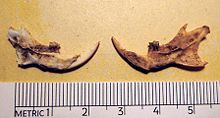라가미스
Rhagamys| 라가미스 시간 범위:후기 플리스토세 | |
|---|---|
 | |
| 과학적 분류 | |
| 킹덤: | 애니멀리아 |
| 망울: | 코다타 |
| 클래스: | 포유류 |
| 순서: | 로덴티아 |
| 패밀리: | 무리과 |
| 부족: | 아포데미니 |
| 속: | †라가미스 소령, 1905년 |
| 종: | †R. 치아교정 |
| 이항식 이름 | |
| †라가미스 교정치료 헨젤로1856번길 | |
라가미스는 무리나에 아과에 속하는 설치류, 구세계 쥐, 쥐의 멸종된 속이다.속은 스위스 동물학자 찰스 임마누엘 포사이스 소령이 헨젤의 들쥐 또는 속 속의 유일한 종인 티헤니아 들쥐로 알려진 라가미스 교정을 수용하기 위해 제정했다.지중해의 코르시카 섬과 사르디니아 섬들에 귀속되어 있었는데, 그곳은 후기 플리스토세 화석의 기록에 처음 나타났으며, 크기는 50g에 이르는 비교적 큰 규모였다.[1]
분류학과 진화
원래 라가미스 마이너(Rhagamys minor)로 확인되었고, 초기 및 중간 플레이스토세(Pleistocene)로 거슬러 올라가는 다른 종의 화석도 코르시카와 사르디니아에서 발견되지만, 이 종은 라가포데무스에 재분배되었다.라가미스 교정은 라가포데무스와 밭쥐(아포데무스)와 가장 밀접한 관련이 있는 것으로 보인다.어금니는 나무쥐(Apodemus sylvaticus)와 줄무늬 들쥐(Apodemus agrarius)와 비슷하지만, 거칠고 연마성 식이요법을 먹기에 적합한 하이포톤치(hypodon dee)로 더 크고 더 파생된다.[1]시간이 흐르면서 라가미스 교정은 크기가 커졌고 넓은 발가락의 들쥐(Apodemus mistacinus)보다 커졌다.[2]
역사
Before the arrival of man on the islands in about 6500 BC, Corsica and Sardinia had their own endemic fauna which besides Rhagamys orthodon included the Tyrrhenian vole (Microtus henseli), the Sardinian pika (Prolagus sardus), two large shrews (Episoriculus), one on each island, a mole (Talpa tyrrhenica), the Sardinian dhole (Cynotherium sardous),수달(알가롤루트라 장조)과 작은 사슴(메갈로케로스 카지오티)이다.사슴은 곧 멸종했지만 다른 종들은 AD 1천년까지 인간과 공존했다.그들은 후에 멸종되었고 이것은 자연산림이 잘려나가고 농경지로의 토지 이용의 변화 때문일지도 모르지만, 검은 쥐(Rattus rattus)의 도입과도 관련이 있을 수 있다.[1]사르디니아 pika는 마지막 남은 육지 풍토 포유류로, 1774년까지 타볼라라라 섬에서 생존했으며, 몇 세기 전에 본섬에서 멸종되었다.이 섬에서 여전히 유일한 풍토 포유동물은 사르디니아 긴귀박쥐(플코투스 정어리)이다.[3][4]
참조
- ^ a b c Musser, G.G.; Carleton, M.D. (2005). "Superfamily Muroidea". In Wilson, D.E.; Reeder, D.M (eds.). Mammal Species of the World: A Taxonomic and Geographic Reference (3rd ed.). Johns Hopkins University Press. pp. 1496–1497. ISBN 978-0-8018-8221-0. OCLC 62265494.
- ^ Alexandra van der Geer; George Lyras; John de Vos; Michael Dermitzakis (2011). Evolution of Island Mammals: Adaptation and Extinction of Placental Mammals on Islands. John Wiley & Sons. p. 124. ISBN 978-1-4443-9128-2.
- ^ Mucceda, M.; Kiefer, A.; Pidincedda, E.; Veith, M. (2002). "A new species of long-eared bat (Chiroptera, Vespertilionidae) from Sardinia (Italy)" (PDF). Acta Chiropterologica. 4 (2): 121–135. doi:10.3161/001.004.0202.
- ^ Amori,Giovanni; Gippoliti, Spartaco; Luiselli, Luca (2013). "A short review of the roles of climate and man in mammal extinctions during the Anthropocene". Anthropocene—Natural and Man-made Alterations of the Earth's Fragile Equilibrium. 25: 95–99. doi:10.1007/s12210-013-0240-6. S2CID 84651348.


